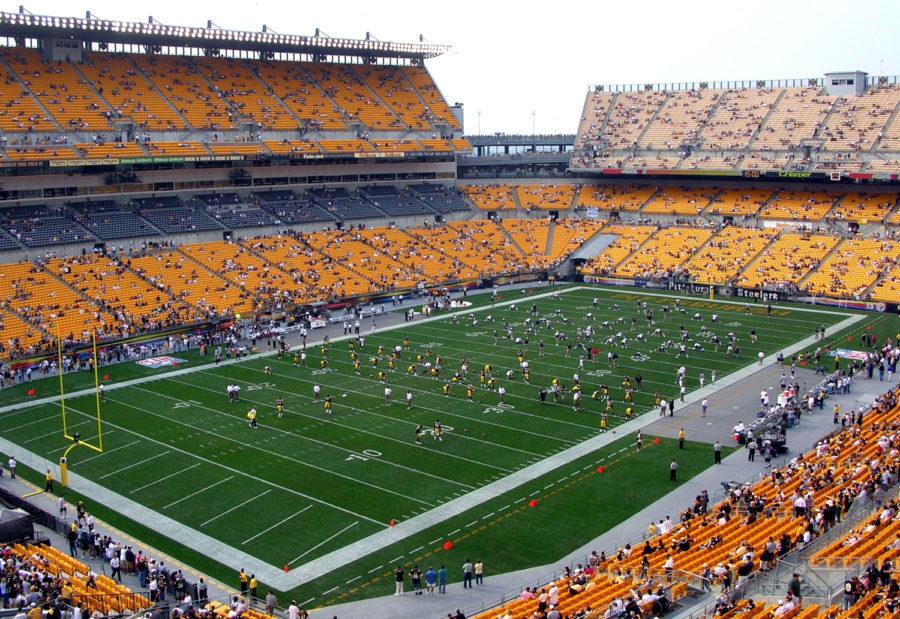Pitt, Heinz Field ahead of the curve on alcohol policies
The Panthers say they are working on attendance plans, and will announce them “very soon.”
April 11, 2019
Ever since the destruction of Pitt Stadium in 1999, Pitt football fans have lamented the locale of the current football facility, Heinz Field. There are some reasonable complaints to be had about Pitt’s home stadium: the distance from campus, the at-times excessively large capacity and even the bright yellow seats that stick out when they are empty.
But despite its drawbacks, Heinz Field actually provides fans with a rare service: beer sales.
Because of its location outside of the University of Pittsburgh’s campus borders, Heinz Field is allowed to sell alcohol on Pitt football game days. Pitt rules state that alcohol is restricted at “events involving groups within the University community.” That would include any athletic events, but in 2016 an exception was made for football games at Heinz Field.
The home of Panthers football was a recent addition to the rapidly growing list of college athletic venues that sell alcohol. In the past decade, that list has grown from less than a dozen to 52 of the 129 Football Bowl Subdivision programs.
Part of the willingness to be flexible with their alcohol policy stems from a problem that has plagued even college football’s elite programs.
Across the country, fan attendance has been declined drastically. 2018 saw the second largest year-to-year attendance drop ever, with average home attendance across the FBS down 3.23% from 2017.
Even perennial national title contenders like the University of Alabama have struggled to fill seats for the entirety of a three-hour football game. That phenomena caught the attention of Crimson Tide head coach Nick Saban, who called out the students for a lack of enthusiasm.
There are a number of reasons why attendance has dipped in recent years. At Alabama, some home games kick off at 11 a.m. local time, which is an early start for students and tailgaters.
Also, the total cost for tickets, food and parking can reach unreasonable rates for a still-inconvenient experience. That assessment also fails to include nights in a hotel and travel expenses for fans traveling from out of town.
And with expanded television rights and an overall improved home viewing experience on television or through streaming services, fans have less of an incentive to spend the time, money and effort on an in-person experience.
Administrators have tried the typical lures to bring fans back to the stadiums, but promotions and giveaways don’t exactly sell out stadiums. So schools have turned to alcohol not only as an attraction but an additional source of revenue as well.
The money earned from alcohol sales can vary dramatically. The University of Florida began selling alcohol at its football and men’s basketball games in 2016, but because of conference regulations, it was only allowed at premium seating.
The intention wasn’t initially to add a massive revenue stream and as a result of the limited sales, only about $54,000 was generated in its first year. But schools that offer alcohol sales through their entire stadiums saw much larger sums.
The University of Texas leads the pack, generating upwards of $3 million from alcohol sales per year. Ohio State also took advantage of its thirsty fans. Ohio Stadium, the home of Buckeye football, raked in more than $1.2 million in alcohol revenue in 2017, up 5.6% from a season prior. Some venues also found that more drinking also leads to greater food sales.
While Pitt has not released any data on its gains from alcohol sales, estimates at the time of the announcement expected the new policy to bring in an extra $500,000 per season.
Obviously, not every school is Ohio State or Texas, so inevitably there are venues that actually lose money because they have to split profits with vendors and pay for extra security to handle the additionally rowdy fans.
But the heightened security might not actually be as necessary as some think. At West Virginia University’s Milan Puskar Stadium, police reported a 35% decrease in alcohol-related offenses from 2010 to 2011, when beer sales began.
Even Ohio Stadium, which did report an increase in stadium arrests from the 2016 to 2017 seasons, acknowledged that most of the arrests ended with a fan being removed from the stadium and not sent to jail. Additionally, most of the people arrested were underage students attempting to buy alcohol.
It’s a somewhat counterintuitive approach. University administrators want to cut down on drinking inside residence halls, fraternities and sororities, so to not just allow it, but actively encourage it at sporting events seems hypocritical.
But there is evidence to suggest that selling alcohol inside of stadiums can help cut down on dangerous binge drinking, which 38% of college students do at least once a month, according to the National Institute on Alcohol Abuse and Alcoholism.
According to NCAA Vice President of Regulatory Affairs Oliver Luck, alcohol sales, in addition to policies that restrict re-entry into stadiums, can help curb that dangerous practice and actually keep students safer by providing a controlled environment for them to drink in.
The logic is sound: if alcohol is sold in the stadium, people are less likely to overdrink before entering the stadium in order to “keep their buzz” for a three-hour game. The data is not yet conclusive, but evidence from Ohio State and West Virginia suggests these are policies worth exploring.
The Petersen Events Center, the home of Pitt men’s and women’s basketball, has not yet followed Heinz Field’s lead on beer sales, but a trend is forming that Pitt’s other revenue sport may soon follow.
While some may consider it unsavory, college administrators are recognizing the financial and safety benefits of selling alcohol at sporting events. And whenever Pitt fans find themselves bitter about the trek across the Veteran’s Bridge on fall Saturdays, they can be grateful that their quest for a cold beer won’t be as taxing.



